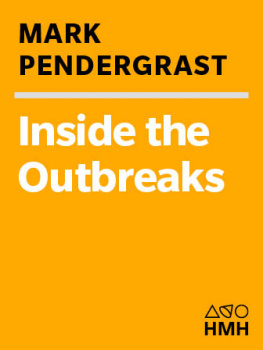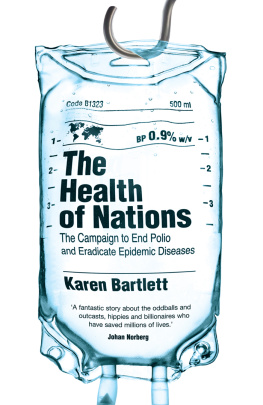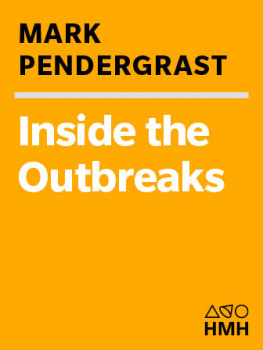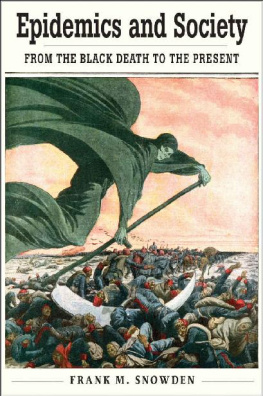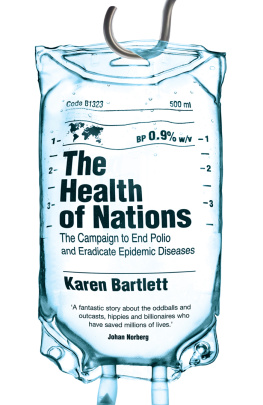First Mariner Books edition 2011
Copyright 2010 by Mark Pendergrast
All rights reserved
For information about permission to reproduce selections from this book, write to or to Permissions, Houghton Mifflin Harcourt Publishing Company, 3 Park Avenue, 19th Floor, New York, New York 10016.
www.hmhco.com
The Library of Congress has cataloged the print edition as follows:
Pendergrast, Mark.
Inside the outbreaks : the elite medical detectives of the Epidemic
Intelligence Service / Mark Pendergrast.
p. cm.
Includes bibliographical references.
ISBN 978-0-15-101120-9
ISBN 978-0-547-52030-8 (pbk.)
1. Centers for Disease Control (U.S.). Epidemic Intelligence ServicePopular works. 2. EpidemiologyPopular works. 3. EpidemiologistsUnited StatesPopular works. I. Title. [DNLM: 1. Centers for Disease Control (U.S.). Epidemic Intelligence Service. 2. Communicable Disease ControlhistoryUnited States. 3. EpidemiologyhistoryUnited States. 4. History, 20th CenturyUnited States. 5. United States Government AgenciesUnited States. WA 11 AA1 P397i 2010]
RA 653. P 46 2010
614.4dc22 2009029871
e ISBN 978-0-547-48723-6
v2.0915
This book is dedicated to all who
work to protect the public health, and
to the memory of my friend Liz Lasser,
who died of malaria in 2003
at the age of forty-nine.
The Parable of the Clinician and the Epidemiologist
T HE BROWN RIVER usually flows lazily through the middle of town. But today it is a torrent carrying human bodies. Some, still alive, are gasping for air and thrashing the water.
Approaching the river to enjoy lunch on its banks, two doctors, horrified by what they see, begin to haul people out of the water. There are no signs of violence, but the victims eyes are glazed, their weak pulses racing.
The doctors cannot keep up with the flow of bodies. They save a few and watch helplessly as the others drift beyond them.
Suddenly, one of the doctors lowers an old man to the ground and starts to run. What are you doing? yells the other doctor. For Gods sake, help me save these people!
Without stopping, she yells back over her shoulder, Im going upstream to find out why theyre falling in.
Introduction
S INCE ITS FOUNDING IN 1951 by Alexander Langmuir as a service/training program, the Epidemic Intelligence Service, working out of the CDC in Atlanta, Georgia, has sent out more than three thousand officers to combat every imaginable human (and sometimes animal) ailment.
These young peopledoctors, veterinarians, dentists, statisticians, nurses, microbiologists, academic epidemiologists, sociologists, anthropologists, and now even lawyerscall themselves shoe-leather epidemiologists. EIS officers have ventured over the globe in search of diseases, sometimes in airplanes or jeeps, on bicycles, aboard fragile boats, on dogsleds, atop elephants and camels.
EIS officers generally have performed their tasks without fanfare or notice. They have saved uncountable lives, preventing uncontrolled spread of disease and diagnosing problems before they escalated. They even may have saved your life, though you were probably unaware of it.
Inside the Outbreaks follows Epidemic Intelligence Service officers in their efforts to solve medical mysteries. Through their stories, readers will learn about the causes of epidemics, the threat of bioterrorism, environmental hazards, and chronic diseases, as well as about societal problems such as violence, malnutrition, and overpopulation.
The first EIS officers were mostly young white male U.S. physicians avoiding the military draft. Today about 15 percent of each class comes from other countries, and over half are female. Many arrive in the EIS with extensive experience and education in public health, and others come with Ph.D.s or other non-M.D. training. The average age of the EIS recruit has increased from twenty-seven to thirty-four.
The EIS has carried on the tradition of field epidemiology begun in the mid-nineteenth century by John Snow, among others. By going door-to-door in London, mapping cases during an 1854 cholera outbreak, Snow noted that infections in one area centered around the Broad Street pump and that employees at a nearby brewing company, which had its own springwater (and sanitary beer), remained well. Snow concluded that an infectious agent must be in the public water supply. On his advice authorities removed the pump handle and the epidemic ceased. As Alexander Langmuir put it, such direct field observations, orderly arraying of evidence, and incisive inductive reasoning have set a pattern for all epidemiologists to emulate today.
Early EIS officers, like Snow, employed simple descriptive epidemiology, looking for the frequency and pattern of an outbreak by examining a particular time period in a well-defined place and population. Over time, the EIS methodology has become more sophisticated, employing case-control studies, computing odds ratios, and utilizing other complex statistical analyses.
Even today, though, epidemiology is a science of probability, not proof. If everyone who drinks the water from a particular source gets sick, and no one else does, it is a good bet that there is something harmful in the water. But only when the same pathogenic strain is found in victims stools and in the water will the case be proved. EIS officers must constantly be on guard against confounding factors, i.e., everyone who drank the water did so because they had eaten hot Tex-Mex food, and the food was at fault. Correlation does not necessarily equal causation.
In the 1950s and 1960s there was widespread optimism that infectious diseases could be defeated with proper antibiotic use, vaccines, and sometimes quarantine, but pathogens developed resistance to antibiotics. Disease carriers such as mosquitoes were difficult to control. Not all diseases had effective vaccines, and immunization sometimes caused its own problems. The infrastructure to deliver vaccines to every child was difficult to build, even in the United States, while posing a huge challenge in the developing world. Also, as humans have invaded every ecosystem, and as modern technology has changed our way of life, emerging diseases have appeared.
The focus of the original EIS was primarily domestic, but as the program evolved, EIS officers ventured overseas with increasing frequency in the belief that if the disease burden is reduced elsewhere, it is less likely to be imported to the United States. But most EIS officers and CDC employees believe that humanitarian concerns alone justify international work. Indeed, diseases such as malaria, smallpox, AIDS, and cholera disproportionately ravage the developing world and appear throughout the history of the EIS.
The book is divided into three sections. , Complex Challenges, brings the saga to the present.
While in general I chose epidemics that highlighted successful disease detectives, not all EIS investigations have solved medical mysteries. I have also included a few diseases whose etiologies still remain unknown, as well as some pseudoepidemics.
A note on bureaucratic structure: The EIS is a service/training program of the CDC, which is part of the U.S. Public Health Service in the Department of Health and Human Services. Many EIS officers enter the USPHS Commissioned Corps, a uniformed service originally connected with the U.S. Navy. Others become federal civil servants. After their two years in the EIS, alums often remain at the CDC, but they are under no obligation to do so.
No organization is without flaws or failures, and this, of course, includes the EIS and the CDC. The overarching take-home lesson from this history, though, is that dollars spent on public health surveillance and prevention programs are cost-effective. In the United States, we tend to react to health problems and seek heroic individual clinical resolutions, spending most of our health budget on extreme measures. Because public health efforts like those of the EIS are largely invisiblefew people know they are being protectedthey are both undervalued and underfunded, despite their efficiency.
Next page
